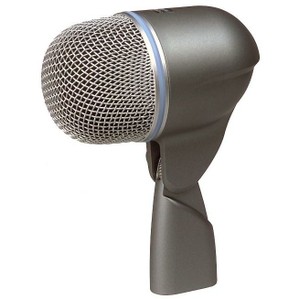Large diaphragm supercardioid dynamic mic for the kick drum

![]()
It’s a Shure! You can always trust they dump an incredible amount of research and development into their products. The Beta 52A runs a wide frequency range, granting the audio engineer access to all the kick’s overtones, if desired.
![]()
This mic’s frequency range can be a bit overwhelming at times. You may find yourself rolling off the bottom end for cleanliness and to avoid damaging your monitors or sound system. It’s definitely not for every kick drum and musical style, either.
![]()
Probably one of the top kick drum mics available in this price bracket, the Beta 52A will blow your hair back and rattle your innards.
A Mic with a Kick
Probably one of the top kick drum mics available in this price bracket, the Beta 52A will blow your hair back and rattle your innards.
The kick drum makes people dance. It’s the element in music that causes head bobbing and, eventually, rhythmic convulsions. If people aren’t dancing, check the kick’s dynamics in the mix. You can start with the mic. I would only entrust the kick to the best mics available. I occasionally break out the Shure Beta 52A to get the job done right.
The Beta 52A is a knobby dynamic with a large diaphragm. There’s nothing modest about its design: it looks like a mean kick drum mic… and it is. That’s why you’ll find it on so many stages and in studios everywhere.
One unique feature of the Beta 52A is its XLR connector. It is built into the mic’s mount. So instead of sticking straight out the back end, as with normal mics, the XLR connector and cord run down parallel with the mic stand. This adds greater stability, less pressure on the connectors and less likelihood of someone tripping on a protruding cord. That’s an invaluable feature since the mic is normally only a foot or so off the ground!
Frequency response of your kick drum mic is crucial, lest you’ll be fussing with your EQ for a half-hour. In a close-miking setup (1/8 inch from the sound source; in this case the kick’s port), the Beta 52A’s frequency curve gives roughly a +6dB/octave starting around 700Hz and extending down to about 50Hz, where it finally plains off. That low-end boost drops as the mic gets further from the sound source.
For the kick’s snap and presence, the 52A has a low-Q, high-end boost of about +7dB, reaching its pith around 4kHz. To reap the full benefits of this mic’s tone, I’ve found mounting it right in front of the kick’s port delivers superb results. Although its SPL is capable of handling 174dB, I strongly advise against dropping the Beta 52A in the kick drum. In my experience, it compromised the tone and made the kick generally harder to control, especially without a gate.
Mic selection for your kick is important, too. Just like choosing the right vocal mic for a singer, choosing the right kick mic will change your entire perspective of how your kick sits in the live or studio mix. The Beta 52A is not for every kick drum or style of music. It’s perfect for well-tuned smaller kicks, but proves too “boomy” for larger, undampened kicks, unless that’s your desired result. For styles where the bass guitar isn’t too dominant (i.e. jazz or classic rock) the Beta 52A is a dream. For styles where the bass guitar is shelved for nothing more than bottom end (i.e. reggae or hip hop), the Beta 52A may be too much.
The only problem I have with the Beta 52A is it delivers too much lower end. Sometimes the music I mix requires a rather narrow bandwidth for the kick to allow more room for the bass guitar. This is a relationship conflict as old as dirt. I find myself rolling off a lot of the lower end, usually starting around 70Hz at –12dB/octave. I also swoop out a lot of the mid-range, a low-Q cut around 600Hz. This shapes the Beta 52A into a single-minded mic, with little room for overtones.
However, the best kick I have ever recorded was with the Beta 52A. It was such a good recording that I sampled it and keep it in my drum library as my pride and joy. Then I’ll use Digidesign’s SoundReplacer to drop it in place of kicks I don’t particularly like (after the drummer leaves the studio, of course).
Technical Info:
Type: Dynamic (moving coil)
Frequency Response: 20 to 10,000 Hz
Polar Pattern: Supercardioid, rotationally symmetrical about microphone axis
Output Level (at 1,000 Hz): Open Circuit Voltage: -64 dBV/Pa* (0.6 mV)*1 Pa = 94 dB SPL
Impedance: 150 ohms (45 ohms actual) for connection to microphone inputs rated low Z
Maximum SPL: 174 dB at 1000 Hz (calculated)
Price: +/- $190
Be sure to check out the other Microphone Reviews
Were to Buy:
You can find this Mic on this Insturment Pro Page. It may also be available on the American Musical Supply Site

Speak Your Mind